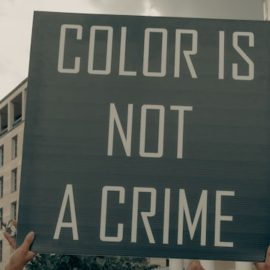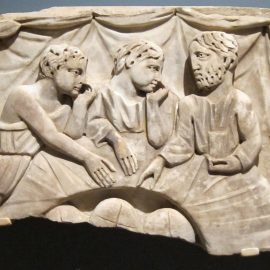

This article is an excerpt from the Shortform book guide to "Caste" by Isabel Wilkerson. Shortform has the world's best summaries and analyses of books you should be reading.
Like this article? Sign up for a free trial here .
Does a caste system exist in the American society? What is the foundation of the American caste system?
According to Isabel Wilkerson, the author of Caste, the American caste system was based on the arbitrary differences in people’s appearances, specifically skin color. The dominant caste used it as a parameter to stratify society and justify different treatment and living standards.
Read about the structure and history of the American caste system.
The History of the American Caste System
The house of America was built on a foundation of a caste system placing whites at the top and black people at the bottom. The infrastructure of the social and political landscapes is based on a human hierarchy developed 400 years ago when Europeans first came to this land.
The terms “cast” and “caste” have different meanings, but there’s a relationship between them that explains the development of race in colonial America, the advent of slavery, and the current social and political landscapes. For instance, a play involves a cast of characters given specific roles and directions for how to perform their parts. The identities of the actors disappear when they take on the characteristics of their role, and everyone knows their significance in the production. The leads are given special treatment, like private dressing rooms and the most lines, and they’re not expected to interact with those in the background who have no lines but are needed to make the narrative work.
Over the long career of a play, the actors change many times, but the characters remain the same. The new cast wears the costumes and assumes the characteristics handed down from their predecessors. The longer they perform their roles, the more the behaviors and lines become automatic. If any actor performs beyond the confines of their character or goes off script, the other actors keep them in check, or they are fired or written out of the story.
The roles Americans have played from one generation to the next within the original narrative of caste are similar. The directions guiding our behavior have not changed, nor have the expectations for how each of us fits into society. And if a member of the lowest caste tries to upstage the dominant caste or change the script, they’re kept in check with laws or violence, or they’re cast out to the margins of civilization.
The American caste narrative started with slavery and continues to be performed over and over. And the subordinate caste’s desire to rewrite the script led to a civil war, the Civil Rights Movement, and continued protests for equality in the modern era. To truly understand why we are the way we are, we must look to the original narrative.
The Structure of the American Caste System
The American caste system was based on differences in people’s appearance. This arbitrary manner of differentiating one group from another is what developed the concept of race. Without it, race would not carry the importance it does today or even be something we assign meaning to.
Race is an unwavering line drawn in the sand because it’s immediately noticeable. Skin color becomes the cue that triggers ingrained stereotypes and assumptions about how people fit into society. As these beliefs deepen, so do the expectations for what a certain group is capable of, where they should live, what they’re allowed to achieve, and what freedoms they can possess. These expectations get passed from generation to generation without question, enhancing social inequities and injustice for all future generations.
Race and caste are not synonyms, but they support each other within American culture. Race is the physical evidence of difference and the significance assigned to that evidence. Caste is how we organize that evidence to maintain division among groups and ascribe the appropriate lifestyles.
The Relationship Between History and Modern Society
Before there was a United States of America, there was a vast wilderness that was conquered and turned into territories. The Europeans who claimed the land in the 1600s saw an opportunity to build a prosperous existence, but to do so, they needed to turn the wild into civilization. The indigenous people were unwilling to help develop their ancestral land, so they were murdered or exiled. The next best option was to find a group of people the Europeans could control to extract the untapped resources of this pristine landscape.
For centuries, religion was the guiding distinction between who had power and who didn’t in Europe. At the top were Protestants, who used the Bible as evidence of their God-given superiority. British Christian missionaries conquered other undeveloped nations and exerted their power by colonizing the natives. Therefore, the decision to use the same tactic to develop this new world was easy. Europeans transported African people to the new world to continue building their kingdoms.
Africans were not the only people initially enslaved to help build the new world. The ranking of Europeans followed a line of heritage and religious affiliation to dictate who could be forced into labor and who couldn’t. Non-Protestant English and Irish immigrants were made to work, but because they were Christians, they were afforded more freedoms. The Africans had not yet adopted Christianity into their culture, so this distinction validated their inferior treatment.
However, once Africans started to convert to Christianity, the religious distinction vanished, and the Europeans needed a new way to justify their subordination. The obvious choice became the stark contrast in skin tone. Thus, they invented two classifications of people—those with light skin became one group called “white,” and those who were not white became “black,” or the opposite of white.
This series of events created the thought patterns upholding the bipolar infrastructure of the American caste system still ingrained in our culture. The power hierarchy developed based on skin color is still the guiding principle used today to determine who people are, where they belong, and what they deserve. Like language, these ideals are learned at a young age and automated into our view of society. We don’t think about how we talk, we just speak. Likewise, we don’t think about why white supremacy is the norm in America, we just move through life understanding that standard. The ranking system is the fabric of American life and considered a given instead of a choice.
Violence as a Habit
People in the American dominant caste lynched, hung, sexually assaulted, and burned at the stake subordinate members from the moment they brought them to the new world and well into the 20th century. These actions were unlawful when the victim was from the dominant caste, but there were no restrictions on the level of violence directed toward the subordinate caste. Violence was a critical part of the American caste system.
Torture on plantations was so common, the different methods had identifiable names. “Bucking” involved tying a slave to a stake in a seated position and forcing them to rotate while being whipped. The whipping could last up to three hours, and the abusers poured salt and red pepper into the wounds afterward. The “picket” was a sort of gallows-like contraption that slaves were fastened into for whipping. It took one enslaved man a month to recover enough to be removed from the picket and five months before he could walk again.
During slavery, owners would advertise their abuses on flyers made to locate runaway slaves. Under the description of the slave, an owner might note that he’d branded the runaway’s face with his initials or castrated him. The signs might encourage those who found the runaways to kill or abuse them upon capture if necessary.
Psychological Torture
Terror was also a daily tool used to regulate the behaviors of the subordinate caste in the South. The dominant caste kept subordinates in a consistent state of psychological terror to further diminish their spirit.
Slave owners strapped slaves into a contraption with metal spikes suspended a few feet above their heads to keep the threat of violence alive. This form of torture could be in response to anything from attempting to escape to not smiling wide enough at auction.
Both the Nazis and Americans had the habit of forcing other subordinate caste members to do the dirty work of abusing someone. This enabled the dominant castes to reinforce their power and the psychological terror of their captives. The fear of receiving the same punishment influenced the actions of the prisoners, and performing these acts of violence themselves damaged their sense of self.
Both dominant castes took this subjugation further by uplifting one member of the subordinate caste to a power position. In the concentration camps, the kapo was the head prisoner in charge of the other Jews in their cell block. On the plantation, the head slave was called the slave driver. Both positions were given enough power to discipline the other prisoners if necessary, which created dissension among the subordinate castes.
The Lasting Effects
Violence and terror reminded the enslaved of how little power they had over their bodies and warned others to stay in line. But when slavery was abolished, the investment the dominant caste had in those black bodies disappeared, and the nature of the violence and terror changed.
The favored action against blacks after Reconstruction changed from whippings to lynchings, often from highly visible trees that townspeople passed by every day. In fact, until the 1950s, there was a lynching in America every three or four days. The time of physical imprisonment was over, but the psychological imprisonment continued.

———End of Preview———
Like what you just read? Read the rest of the world's best book summary and analysis of Isabel Wilkerson's "Caste" at Shortform .
Here's what you'll find in our full Caste summary :
- How a racial caste system exists in America today
- How caste systems around the world are detrimental to everyone
- How the infrastructure of the racial hierarchy can be traced back hundreds of years






